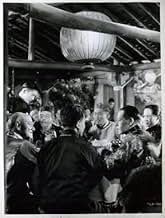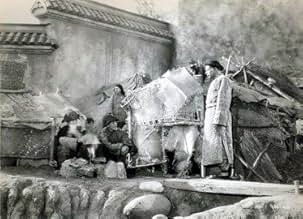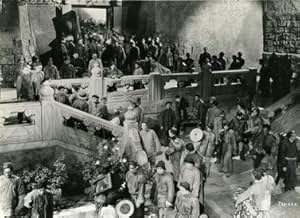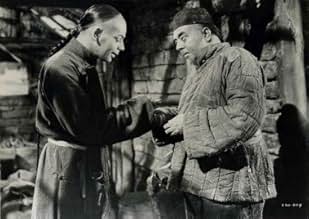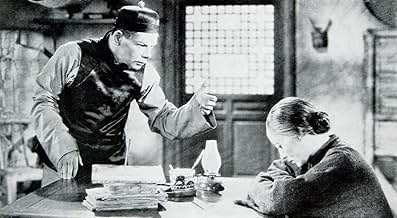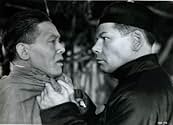Aggiungi una trama nella tua linguaAlthough married Chinese farmers Wang and O-Lan initially experience success, their lives are complicated by declining fortunes and lean times, as well as the arrival of the beautiful young ... Leggi tuttoAlthough married Chinese farmers Wang and O-Lan initially experience success, their lives are complicated by declining fortunes and lean times, as well as the arrival of the beautiful young Lotus.Although married Chinese farmers Wang and O-Lan initially experience success, their lives are complicated by declining fortunes and lean times, as well as the arrival of the beautiful young Lotus.
- Vincitore di 2 Oscar
- 7 vittorie e 3 candidature totali
- Revolutionary Army Captain
- (non citato nei titoli originali)
- Man
- (non citato nei titoli originali)
- Teahouse Dancer
- (non citato nei titoli originali)
- Chinese Girl
- (non citato nei titoli originali)
Recensioni in evidenza
The story begins on the wedding day of Wang Lung (Paul Muni), a kind and gentle farmer. His wife, O-Lan (Luise Rainer), bears his sons and quietly encourages him to pursue his dreams, no matter what sacrifices they entail from her. The family lives through a famine and finally achieves prosperity and success. However, with success comes greed and corruption, and soon Wang is buying large plots of land and the Great Hall at which O-Lan was a servant. Eventually, he takes a second wife and breaks ties with all who were once close to him. It takes a tragedy for him to see the error of his ways.
All the while O-Lan stands behind him, supporting every decision he makes in her own tranquil way. Rainer's Oscar winning portrayal, like O-Lan herself, is the glue that holds the story together. Muni, often prone to hamminess in his work, shows restraint here and contributes a beautiful, multifaceted performance. The cinematography, which also received an Oscar, is excellent, as are the special effects. A sequence which involves locusts, invading the crops by the million, is nothing short of unforgettable. It is storytelling in the grandest sense of the word, with strong characterizations, high production values, and an engrossing story which more than justifies `The Good Earth's status as a classic.
For those people who thought "The Good Earth" was dull and not entertaining, I have nothing to say. They are entitled to their opinion, but they missed one of life's most important lesson's: Humility and loyalty.
I was fortunate to see this film when it was FIRST released - in 1939. It's wonderful story (Pearl S. Buck) written for film (Talbot Jennings) has stayed with me all through my long life. I saw it in a theater then; I found it in the "garbage bin" in Wal-Mart this year (2011) and bought it immediately....I had it in a huge collection I gave to a library in Los Angeles when I moved to Florida. The copy I have now was made from the original cut - there are black screens between big scenes. I don't remember that after all these years, but accept it was the way the early release looked. It doesn't bother me - it gives me more time to think of what I have just viewed and anxious to see what's next. To me, the story is so engrossing the length of the film doesn't even occur to me - I would have liked the ending to be longer, because "Olan, you are the earth" told the entire reason for the story of true love and devotion, to the extreme.....
I'm not even bothered by the question so many people asked of why Paul Muni ("Wang Lung") and Luise Rainer ("Olan") were cast instead-of Asians - I had never seen Ms. Rainer in any film, and have no idea why her Hollywood career faded. She was considered to be a great beauty. Paul Muni I've seen in other films, but he wasn't one of my favorites. Yes, I have always wondered how "Gone with the Wind" - beat it out of an award: actually, I thought "The Good Earth" was filmed in color. Now, I'm not even concerned about that - the STORY, the ultimate entirety of the film's huge scenes and huge cast dismisses any negative comment I could think of, or read.
Walter Connolly ("Uncle") and Charlie Grapewin ("Old Father") were perfectly cast and played their roles with great skill. All of the cast were consummate in their roles; director Sidney Franklin held a strong grip of the totality of the film and got it all right. As time progressed into a more modern era, the characters became more modern: except, "Olan" stayed the wonderful woman she was.
However - Ms. Rainer stole the entire movie. A good actress does not always need words to say. I feel the story of a peasant-farmer and his ex-slave wife, all of the troubles they encountered (and defeated), the entire cast presented an accurate portrayal of the story in those days - China. It is hard for me to visualize any re-make could be better, and feel any CGIs would be completely unnecessary. It is also hard for me to realize China's last emperor was alive when I went to Hawai'i in 1969......living a peasant-life, just as did "Wang Lung" and "Olan".
Anyone who views "The Good Earth" and doesn't readily understand that life is bigger than any of us, haven't really lived. It gets a 20 from me - I recommend it to every living soul.
It was soap-operish at times but had some visually dramatic moments, too, capped off by a locust attack at the end of the film. That was astounding to view. Considering this film is about 70 years old, the special-effects crew on this film did a spectacular job.
Paul Muni and Luise Rainer were award-winning actors in their day and they don't disappoint here, both giving powerful performances. The only problem is credibility as all the Asians are played by Caucasions and some of them, like Walter Connolly, just don't look real. I'd like to see a re-make of this movie with all-Asian actors, not for PC reasons but to simply make the story look and sound more credible.
This was the first movie I saw at New York's Museum of Modern Art, around 1970 (I was a teenager). Expensive looking yet with scenes of such poverty, masterfully photographed, often thrilling, and always engaging, to me it was MGM movie-making at its best. What did audiences feel when they glimpsed a locust attack, the person by person destruction of a mansion, the horrific poverty and then the splendor of wealth.
Last week, those watching the Academy Awards had a glimpse of the "senior" Oscar winner in attendance, Luise Rainer. How grand to see an actress who arguably delivered one of the most masterful, haunting performances in history electing to return for a celebration.
Ok, so she should not have won the year before (Great Ziegfeld), but don't blame Luise. Talkies were only a decade old when this was released, and her dialogue limited. But as Olan, her use of visual and vocal is memorable.
Large scale and touching, what more could a movie lover want!
Luise Rainer was the beautiful star who had won the Best Actress Oscar the year before for her small role (and what a waste of an oscar) in "The Great Zigfield". It really didn't show what, if any, talent she had other than her exotic beauty. But in "Good Earth" she shows that she can really act! Her beauty was erased and she had no great costumes either. People say that she didn't show any real emotions in this film. Like hell. Her character Olan is a shy and timid woman, with inner strength. She is quiet during parts of the film with only her eyes and body to convey her emotions. Example: those scenes during the fall of the city and when looters were being shot. If you people are saying that she doesn't act well in this film, you are NOT looking!
Paul Muni shows that he can act as well. His character is not a likeable one to me. He never sees her for what she is, until the very end of the story. A sweet loving and dedicated wife and mother, with her own special beauty. The greatest one of all, the beauty from within, like a pearl.
If you get a chance to see this film, watch it. You will see one of the best films that the golden age of Hollywood created.
Lo sapevi?
- QuizSpecial effects experts were unable to produce an authentic-looking locust plague. Just as they were about to abandon the scene, they received word that a real locust plague was taking place several states away. A camera crew was rushed to the scene to capture it on film.
- Blooper(at around 2h 5 mins) Wang Lung is walking through the locust storm in his wheat field. He picks up a few men who have fallen down into the thick pile of locusts. In frustration, Wang shouts "I said save the wheat! Save it!" At this moment, a man dressed in 1937-era American clothing walks across the scene from left to right, at the top third of the screen. He is wearing a white hat and appears to be smoking a cigarette or cigar held in his left hand.
- Citazioni
Wang Lung: [must sell his land to feed his family but the buyers take advantage of him] Thieves! Thieves! And well you know I must sell.
O-Lan: No! Not the land. We'll not sell the land. We'll keep it. We'll go south and when we return, we'll still have the land.
Uncle: But I've arranged it. I brought these men here. You MUST sell!
O-Lan: Is it your land? Did you buy it bit by bit? The land is our life... and it's better to go south... or die walking... than to give it to you for nothing.
- Curiosità sui creditiIntroduction played with opening credits: The soul of great nation is expressed in the life of its humblest people. In this simple story of a Chinese farmer may be found something of a the soul of China - its humility, its courage, its deep heritage from the past and its vast promise for the future.
- ConnessioniEdited into La stirpe del drago (1944)
I più visti
Dettagli
- Data di uscita
- Paese di origine
- Sito ufficiale
- Lingua
- Celebre anche come
- The Good Earth
- Luoghi delle riprese
- Cedar City, Utah, Stati Uniti(backgrounds for locust sequence)
- Azienda produttrice
- Vedi altri crediti dell’azienda su IMDbPro
Botteghino
- Budget
- 2.800.000 USD (previsto)
- Tempo di esecuzione2 ore 18 minuti
- Proporzioni
- 1.37 : 1



